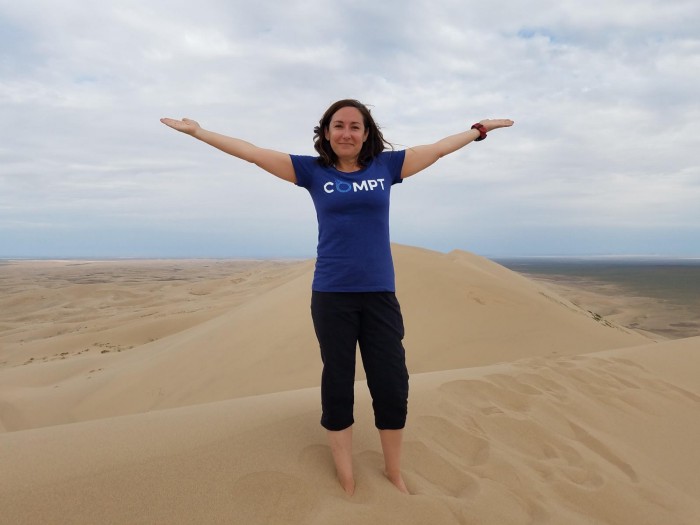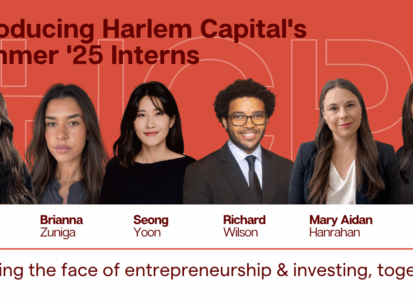More Equity Podcast: Amy Spurling of Compt
by Harlem Capital

Part 2 of the Female Founders Series featuring Amy Spurling of Compt, Harlem Capital company.
In today’s candidate-driven hiring market, it has never been more important for companies to differentiate themselves by more than just their base salary. Nearly 80% of employees would prefer new or additional benefits as opposed to a pay increase. Though trendy startup and tech offices have long offered everything from kombucha on tap to pet insurance, how can companies truly offer their employees benefits that will satisfy their unique desires and needs?
A few years ago, Amy Spurling began thinking about just that. Spurling’s latest company, Compt, offers a platform for personalized lifestyle benefits that allow employees to spend their budget for benefits where and when they want to. Compt gives employers the ability to design and manage perk stipends that delight employees, and ultimately support a more productive and engaged workforce.
Amy is no stranger to the startup world. Over her last two decades in the startup and tech world, Amy has closed fifteen rounds of financing, served as a CFO at three different startups and COO at two, and advised multiple others. We sat down with Amy to discuss her strategies for building an all-star team, why she values diversity on her cap table, and how we can build a more just and equitable tech industry.
Interview has been condensed and edited for clarity.
To start off, you have had an amazing journey through many different parts of the tech world. Could you tell us about your journey and what led you to your current company?
Coming out of business school, I started working for an early stage investment bank. I saw tech companies from the investor side of the table and got to take operating roles in a lot of the companies we worked with. It was really early-stage, we focused on two or three person companies. What I realized was that I like technology companies because they move really quickly and they adapt and they grow. After a few years there, I went in-house for a company where I was working on the finance team, and got to go through the process of the company being acquired by Yahoo, which was really interesting. After I transitioned out, I began jumping from tech company to tech company where I’d help raise money, scale teams, and sell the company. That really influenced why I started my own company.
I wasn’t one of those people who at 22 years old, was like, “Yeah, I’m gonna go start my own company. I hadn’t really planned on that. I liked going through the execution phase of a company, but I kept seeing the same problems over and over again. I kept seeing problem where the way we compensate people hasn’t really changed. Our salaries haven’t gone up dramatically in 15 years. But companies have been trying to figure out, how do we create some differentiation between ourselves and our competitors so we can get the right talent around the table? That’s when everybody got into employee perks. That became a big mess — you know, when you go from the espresso machine to suddenly having kombucha and beer on tap and 45 different kinds of coffee. That’s why I decided to start my own company — I realized that employees should have perk personalization and we need to be able to do that at scale for companies.
For those who don’t know, could you describe briefly what Compt does?
Compt is perk management software that allows companies to decide, what’s going to align with our culture? Are we a family-first culture? Do we really want to focus on health and wellness or learning? You can align your company perks with a particular cultural value, then as an employee, you get to personalize what that looks like. It’s not a vendor platform so there’s not a big laundry list of vendors. It literally allows for an employee to do what matters to them.
For example, for the family category, one of our customers bought a hot water heater. They were sitting at home with their kids in the middle of the pandemic, and their hot water heater blew — which is an absolute nightmare. Their company had the “family” category enacted and they were able to actually get support from their company to fix this issue.
I love that. It’s such a relevant example. I’d love to dive into talking more about the product itself and how you went about building that. Especially at the seed stage, every startup works through the challenge of finding that product market fit. Could you talk about what that was like for you and some of the major pivots you made?
Sure. I spent a couple of years researching and testing out the concept. I knew that as a CFO, I would love this in my company. I actually Googled this idea, assuming that someone would already have built the thing for me. Then, a couple of years ago, I decided to leave my last company and build this because nobody had built it yet.
We really haven’t pivoted the product. I’ve got 20 years of experience in finance and HR and more often than not, I find that products pitched to finance and HR are not built by operators. That means customers will say no, because there are a lot of laws you have to comply with, and if you don’t come from an HR background, you don’t even know what those laws are. So we started hitting product-market fit pretty early.
That’s fascinating. One more question about building your team before we dive into talking about funding and acquisition. With your background across finance and HR, when you were building your team, what were some of the skills or key hires that you were immediately thinking about?
Out of the gate, I knew I needed people with skillsets different from me. That was part of the early focus. I’ve got deep expertise in finance and HR, but I’m not a marketer and I don’t write code. I knew I needed people with those skills and that was part of the early focus. Another stated goal for us as a team was to make sure that we have a diverse team at all times. That’s really hard to do. We wanted to start out of the gate on day 1 with a focus on diversity, because we’re serving all employees and all employees look very different. We need those diverse perspectives on the team so that we build a product for everyone.
We look at nontraditional backgrounds quite frequently, because you’ve got to look in different talent pools. If I only hire MIT engineers, they’re amazing, but you’re going to get the same pool of people that every other tech company is using. So we think about the other skills that people bring to the table.
That’s a great point on diversity and looking at it from a really holistic perspective. I’d love to dive into fundraising. So you’ve been through this seed round for Compt, as well as fundraising and acquisition processes for other companies. So starting with your experiences with Compt, at what point did you begin fundraising and how did you approach fundraising strategy?
Because I’ve come up through tech, I knew that if you’re building a software company, you’re going to need a lot of cash because you’re not going to be profitable for a long time. So I started thinking about fundraising out of the gate from an angel perspective. I did contribute some of my own personal cash as well, but I started looking at angels. It was the first time I was doing an angel round. An angel round is very different from working with institutional investors, there’s no website that says, “hey, I like to invest in fintech or HR tech with this size of check.” There’s a lot of criteria VCs have that make it an easier path to navigate. The other thing I found with the angel investing is I knew that if you want diversity in your team, it needs to be in your investors, your board, all the way through your company. We created a syndicate through AngelList where we could target women and people of color to write smaller checks so that we could get them access to a deal at an earlier stage for a smaller check that was a lot less risky. We allowed them write a check of a couple thousand dollars — you’re not going to retire on that money anyways. So our cap table even before the seed round was about a 50–50 split male-female.
Wow, I love that. I’ve never heard of a startup approaching an angel round like, at least. Have you found that other startups have done this or was it really unique to your team and strategy?
It was something I decided to do. Because it’s not even the way you’re supposed to use Angel List. I wanted to find someone to be a lead on my syndicate, then we just funneled people in. It was a way to get a more diverse investor set, because you can be open to people who wouldn’t necessarily be getting access to deals otherwise. You write your first $2,500 check, make some money, then maybe later down the line, you write a bigger check. Until women and people of color are a bigger percentage of the checks that are being written, we’re not going to change the dynamic of who’s getting funded and how. We need more people who are writing checks who are in different demographics.
Yeah, that’s amazing. Angel investing, even, is notorious for having a huge male investor base. Speaking of women in investing, female founders also have a notoriously hard time raising funding. Were there any gender-specific challenges you ran into when trying to fundraise from predominantly male investors?
The more metrics we had the easier it became. It was harder to get people over the finish line when we had fewer metrics, because then that bias does come into play. Harvard has done so many studies of the questions women get asked vs. the questions guys get asked. The more metrics you have, the more your idea gets proven out, and you get asked different questions down the road.
When I started fundraising for a seed round in January, I targeted firms who really understood our space. If you’re just talking to general VCs who are loosely in our space, and they disagree that there even is a problem, then we really shouldn’t be talking. We can debate all day whether Compt is the right solution — that’s a great conversation — but if you don’t think there’s a problem, I’m certainly not going to convince you. So working with Slack has been great — they totally get the remote team aspect. They actually committed early last fall and were like, let us know when you want to raise, we’re here and we want to write a check as soon as you want to raise.
With Harlem Capital and Impellent, it was the same deal. Both New York investors, but really good conversations because they got the problem and our solution.
Definitely. HR tech is so vast that I can see how for an investor who doesn’t understand the space or hasn’t had experience investing in it it can be tough to outline. Now, turning to some of your previous fundraising experiences, could you talk about some of the key lessons you learned fundraising for previous startups that you were able to apply to Compt?
Over my prior companies, I had done 15 different rounds of financing. Right now is the first time I haven’t been fundraising in 15, 16 years. It’s a nice break for a couple of months. The way you fundraise has definitely changed over the last 2–3 years. It used to be that you have a shortlist, preview what you’re doing, pre-empt the round. That’s shifted towards once you hit go, whether you preview or not, it’s go. And so today, you want to make sure you don’t over-shop your deals.
Other than that, it’s really important to find people who understand your space — people who can add value and have some kind of knowledge in the space. I personally like a diversity of investors from geographies, as well. If I have only Boston investors, I’m going to have people with a very Boston perspective in thinking about how you build a product, how you think about distribution, how you think about go-to-market.
Finally, thinking about the diversity of the board. Who’s on the board has a lot of impact — the board will determine who’s on the management team. I’ve been the only woman on all the other boards that I’ve sat on. At my prior companies, as CFO, I was the only woman in the room every single time. I think there’s only been one board that had anyone who was a person of color. And he was a board observer, not even a voting board member. If you’re dealing with a really homogenous group, you don’t get up getting the most diverse perspectives.
Definitely. And I think one really interesting thing about your experience is you’ve actually had the chance to go through acquisition and be part of that experience, as well. Not a lot of female founders actually get to that stage. As a woman who has gone through that, what were some of the key lessons you learned that you’re now applying to thinking about Compt’s exit strategy?
I planned for it internally from day 1. You keep things clean — clean diligence rooms, clean financials — you think about those things early on so you don’t have to reverse engineer later. It’s for an exit, but it’s also just for scalability — you need the same things in both situations. If you want to build a scalable company, you need to think about making things a repeatable process where it’s not just manual every time.
Right now, we’re interviewing a bunch of people and I realized about 5 minutes in that not everyone on my team has interviewed people before, so we needed to build an interview process. Putting things in place as you scale and grow certainly helps with an acquisition down the road, but it also just helps build a scalable, functioning company which allows you to not have to overhire, which is really helpful too.

A couple of bigger picture questions before we wrap up. You’ve had an amazing career over the last couple of decades. Where have you really seen tech companies move the needle on racial and gender and other types of equity and where do you think there remains room for improvement?
Room for improvement is a long list, in my opinion. Because a lot of it has been built by a pretty homogenous group. There’s just a lot of examples, like, soap dispensers or water dispensers in bathrooms will recognize my skin, but won’t recognize darker skin. That’s because the people building it had lighter skin and it can recognize our skin color. Things like that are just ubiquitous. It’s in every part of our lives. I think that there’s a lot of room to think about things a little differently.
Where I do see improvement is I see people focusing on the pay gap, focusing on the equitable distribution of how we handle our team internally. I don’t think most tech companies set out to be 70% white male, but when you start out pretty homogenous because you hire a couple of your friends who probably look like you, and then you pay for things that keep you happy, which attracts more people just like you — it becomes a self-fulfilling prophecy. I think Compt can help with that, as well. A lot of people actually have good intentions, but their tools haven’t been able to support that.
Awesome. And to wrap up, what part of this journey has brought you the most joy?
Honestly, I get goosebumps when I hear the stories from our customers and the way that employees are being supported. That gets me really excited, because that’s what started this whole thing, was seeing people come into my office and ask things like, “my dad has Alzheimer’s, can you sponsor this walk for Alzheimer’s?” The answer was always no, despite the fact that it was an amazing cause, because if you support them but not employees with other causes, then you’re discriminating against them, and it’s this whole HR rabbit hole that you don’t want to go down. Being able to say yes is really exciting. We had somebody use the funds to go surprise their Mom for her birthday. Things like that really have an impact on employees’ lives and that’s the part that makes me so excited.
Word count: 2,600
Follow Amy and Compt:
Twitter: @Amy Spurling @compthq
LinkedIn: @amyspurling @compt


